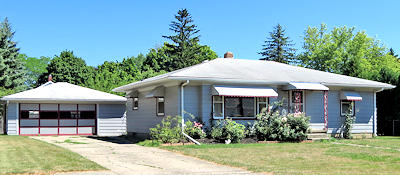A visit to Whimsical Party Gallery
by Maralyn Fink
Opening on July 7th, with 2 paint parties, owner Tracie Davis offers step by step painting to people of all ages.
Spray Park tiles can be painted here, and Tracie is right there to help in any way.
She also does public and private parties.
I met up with some eager painters while I was there, and their names are Jordon Grove, Gabriel Gibat, Jack Daman, Charlie Daman and Nathaniel Gibat. All were seated at a table to paint a tile with excitement in their eyes.
On September 17th Tracie will change the name to The Art Gallery. There are many paintings in the store that were all done by Tracie that are for sale.
Tracie has been painting all of her life and 7 years as a professional. She says it is her passion and just plain fun.
Stop in and see her paintings; there just might be one you have to have.
Thanks, Tracie for the interview and seeing your beautiful paintings.
Oberstufenchor Johanneum zu Luebeck Day in the City of St. Johns
courtesy of Guven Witteveen
On the occasion of the 50th anniversary of the international youth exchange with Blue Lake Fine Arts Camp, on Tuesday the 26th of July -proclaimed the Oberstufenchor Johanneum zu Luebeck Day in the City of St. Johns, Michigan – the group performed sets of songs in English, as well as in German.
This opening to a gorgeous spiritual was one of the numbers, We Shall Walk in Peace.
youth choir 2016 – We Shall Walk in Peace from gp witteveen on Vimeo.
About one third of the young people braved the high temperatures Tuesday morning inside the 90 foot steel silo at Livingston Farms to enjoy the rare acoustic space.

Here is a sample of the singing from memory in the morning before their concert in the park, Remember Me SATB – silo singing,
******
Wednesday evening in the Park
My Sweet Patootie, “What makes you think?”
and one other from the first set,
My Sweet Patootie, “Lead me now.” So much music from three players! This song was inspired by the annual float down a nearby river: people come out in Lake Huron at the town of Southampton and then the parties begin.
This week’s Mystery Photo
Where is this?

Can you tell us where this is located? Drop us a line at mail@sjindy.com.
402 E. Buchanan St.

The current owner is Stephan Geller. Previous owners include William Graef, Donald Gilson, David LaQuire, and John and Marlene Hopko.
Editor’s note: This house is half of the Nick Pappas home that was moved from 102 Spring Street in the 1950s to make way for the office building at the northeast corner of State Street at Spring.
A Look Back – 1912 North Ward Kindergarten
Barry Clark Bauer

This photo was taken at North Ward Elementary School in 1912. The students are identified but the pencil writings are very faint. I know my Uncle Ellsworth Gillson is one of the students.
– Tom Beechler
The chalkboard sign being held by one of the students looks like it says: St. Johns North Ward Kdgn.
The names on the back, as Tom describes, are illegible. A few do stand out, Dutch Eckert, Berthea Kasper, Harry Fields, Edith Fields, Helen Kasper, Glendon Fitzpatrick, Gaylord Corkins, Beatrice Heafty, and Ellsworth Gillson. Dutch Eckert was listed twice and I wonder if he was related to long time friend, Steve Eckert.
See whether you can read more of the names by clicking here.

The North Ward school building was replaced by Perrin Palmer which is also gone.
Random Notes – Summer means Tall Ships
by Rhonda Dedyne
Benny and Jessie’s Pet Info – How Air Fresheners Can Affect Your Pet’s Health
As parents and caregivers, one of the earliest lessons we learn is the concept of “baby-proofing”—keeping toxic substances and dangerous situations well out of the way of our children. As pet parents, we need to do the same. But unlike children, instead of this being a temporary obligation, it’s something we’ll need to do throughout the lives of our pets.
Unfortunately, some of the things we do to improve our environment, such as cleaning or using chemical air fresheners, can pose serious dangers to our animal friends, whether furry, feathered, or scaled.
So, do pet owners need to throw away their room sprays, plug-ins, candles, oils, and solids? That’s a question that’s not so easily answered. However, there are some ways to play it safe when using these products in the home.
“If we are putting some kind of chemical into the air merely to mask scents, then we have to be concerned about the negative implications on our pets,” says holistic veterinarian Dr. Patrick Mahaney of California.
Sadly, most forms of air fresheners, whether room and furniture sprays, solids, and even the seemingly safer alternative of scented candles can be very toxic to humans, and even more so to animals that might ingest the substances accidentally or not have the wherewithal to avoid them in the first place when they’re being used.
According to Dr. Mahaney, one of the main offenders in the ingredient list for most air fresheners are Volatile Organic Compounds (VOC). VOCs are organic chemicals that have a high vapor pressure at room temperature due to a low boiling point. This causes these compounds to easily evaporate from a solid or liquid form into the air. This transformation is called volatility. In other words, volatility is just what air fresheners are meant to do: break down from one form and dissipate into the air, thereby changing its scent.
Unfortunately, this is the same volatility that occurs in paints and varnishes, fossil fuels, benzene, formaldehyde, refrigerants, aerosol propulsion, cigarette smoke, and the dry cleaning process. You wouldn’t open a can of paint in your living room to improve the quality of the air, but this isn’t too far removed from what happens when you break out an air freshener.
These substances can cause a laundry list of maladies, like asthma and cancer, and can affect the blood, brain, heart, liver, kidneys, skin, and the respiratory and nervous systems of both people and their pets.
According to a study cited by LiveScience.com, a test of the top selling air fresheners and laundry detergents showed that these products released a litany of chemicals when used, and in all cases at least one of the chemicals was considered to be toxic.
For those who seek a more natural, non-toxic approach, in recent years, there has been a resurgence in the homeopathic movement—an alternative medicinal approach that uses substances from nature. On its face it seems reasonable enough; eschew the manufactured chemical and embrace what the earth has to offer.
For the air freshener industry, the latest “natural” catch phrase is “essential oils.” Despite this touchy-feely name, these products are by no means entirely safe. Essential oils are also defined as volatile, and while these substances are created from flowers, bark, berries, roots, seeds, and woods, and do have some potential medicinal and positive effects, they can still be very toxic to people and animals, even when they are used properly.
“Essential oils, which are included in many air freshener products, can be very toxic, especially to cats. If you simply have to have essential oils in the home, make sure they are kept in a location where your cats cannot come into direct contact with them,” says veterinarian Dr. Jennifer Coates of Ft. Collins, Colorado.
“Also, birds are more sensitive to potential airborne toxins than are other animals, so I generally recommend a ‘better safe than sorry’ approach with the use of air fresheners around them.”
When it comes to using these products around our pets, a little information is your best weapon of defense. “Read the instructions on the side of the bottle and be sure you are spraying the recommended amount,” says Dr. Mahaney. “When you walk into a room that’s been heavily sprayed with air freshener, what does it do to your eyes and lungs? If it’s doing that to you, it’s also going to do that to your pets.”
So, how do you know if the products you use around your home are relatively safe? Dr. Mahaney recommends doing some research on the ASPCA’s Poison Control Center Website. This resource covers all sorts of toxins that your pet might encounter, from air fresheners, cleaning products, human and pet medications, foods, plants, and other substances. In case of a poisoning emergency, there is a 24-hour hotline at (888) 426-4435, although a $65 consultation fee might be required.
Obviously, in the case of a true emergency, it is far more important to get your pet to a vet than just consult with one by telephone.
According to Dr. Mahaney, the signs and symptoms of the negative effects of air fresheners range from the immediate to a few hours or days after use. When you first use them, a pet might immediately withdraw from the area or cower. A pet might cough, sneeze, produce a nasal discharge, or suffer from vomiting, diarrhea, lethargy, or lack of appetite.
However, these dangers don’t come from the air alone; they can also be caused by contamination from where they fall, where a pet might step, roll, or lick, or from products such as carpet shampoos and cleaners that are specifically made for surfaces.
“If you’re going to spray something that’s going to leave an aroma, I suggest that you don’t give your pets access to it,” says Dr. Mahaney. “If you’re cleaning, you don’t want to leave a significant residue—they could walk across it on a carpet and potentially lick it off their paws.”
Ingesting an air freshener can be even more dangerous than simply breathing it in. Any long-term usage products, such as solid or plug-in air fresheners, need to be closely monitored, and extra care needs to be taken when you dispose of them. If your pet is inclined to go through the trash, you might want to dispose of spent air fresheners directly in an outside trash receptacle.
“If an animal ingests an air freshener, I worry primarily about its effect on the gastrointestinal system,” says Dr. Coates. “The active ingredients and/or the packaging could cause vomiting, diarrhea, etc.” And that is not confined to chemically scented products. “Essential oils can not only affect the GI tract, but they also are associated with neurological problems like agitation, weakness, unsteadiness, and tremors in dogs—and especially in cats.”
“Anything with a fibrous nature to it can cause digestive distress and may be absorbed through the small intestine and get into the blood,” says Dr. Mahaney. “Cats have had increased feline asthma as a result of living in households where there are air fresheners, incense and cigarette smoke—or even just the aroma of cleaning products.”
For expectant mothers, all possible care needs to be taken. Research has suggested that VOCs such as Toluene and Xylene can potentially cause childhood cancers, leukemia, and brain damage, so there’s no reason not to believe that this is also a risk to our pregnant pets. The proper usage of air fresheners and any potentially toxic stuff in them will ensure that future generations of our furry friends will be happy and healthy.
When it comes to 100% safe ways to clear the air, there are still a few alternatives in our modern world. Some types of potpourri (although these still need to be kept out of a pet’s reach so it is not ingested) can be a pretty safe bet, and you can create do it yourself home scents by boiling flowers, fruit rinds, and other natural organics. Or you could try the comfort trick real estate veterans have long used: Replace the funk with the smell of cookies, bread, or apple pie. Creating a sweet smelling home is as good an excuse as any to bake.
Are there any products that are safe for making the house smell nice while being safe for pets? Dr. Mahaney recommends the Glean+Green family of products. Clean+Green manufactures a wide array of products for pets, including air fresheners and fresheners for carpets, flooring, furniture, cars, and litter boxes—and even a de-skunking spray.
They also have products for homes with birds and other small animals, which tend to be more sensitive to chemicals than larger pets. The active ingredients in these products include sugar derivatives, botanical extracts, and hydrated cellulose, and may provide a safer alternative to conventional air fresheners. However, these products are pet-specific and may not be appropriate for use all around the home.
Still Dr. Mahaney wonders why pet owners need to resort to scented products at all. “Why are we freshening our air?” he asks. For a truly effective method of clearing the air, he says, proper ventilation is still king.
So can somebody just open a window in here?
Letters – Victor resident running in August 2 Primary
 A Victor Township resident for 24 years, Kimberly Smith is employed by the Michigan Department of Transportation Bureau of Finance and Administration. She is an Accredited Election Official through the Michigan Department of State Bureau of Elections. Serving for 3+ years as Deputy Clerk for Victor Township Kim managed the office, cemeteries and facility as well serving as the township Election Chairperson and as Inspector for Victor and Ovid Townships. During this time Kim also assisted with operations of the treasurer, supervisor and assessors offices.
A Victor Township resident for 24 years, Kimberly Smith is employed by the Michigan Department of Transportation Bureau of Finance and Administration. She is an Accredited Election Official through the Michigan Department of State Bureau of Elections. Serving for 3+ years as Deputy Clerk for Victor Township Kim managed the office, cemeteries and facility as well serving as the township Election Chairperson and as Inspector for Victor and Ovid Townships. During this time Kim also assisted with operations of the treasurer, supervisor and assessors offices.
Kim is a certified PC Coordinator Specialist through Professional Technical Development in East Lansing and is an IRS Certified Tax Preparation Specialist through H & R Block. Kim also received a General Banking Diploma through the American Bankers Association.
Kim served as the coordinator of the Looking Glass Neighborhood Watch, Clinton County’s largest) group for 14 years providing urgent communications from Clinton County Sheriff and Bath Township Police Departments. Kim is the recipient of Clinton Co. Sheriff Award for quick action in a local farming accident resulting measures which saved a life.
Kim formerly served as Director of Operations for Happendance, a non-profit 501c3 performing arts school in Okemos, ensuring compliance with State Gaming Control Board in fund development activities. Kim served in many management roles and as Recording Secretary and Depositor for the Children’s Ballet Theatre of Michigan as an Executive Member of the Board of Directors.
An avid volunteer in the Laingsburg area, Kim for nearly a decade served as a Rolling Reader and Literary Tutor for At Risk Students as well as the parent led Picture Person Art Program for Laingsburg Schools, was an international certified Girl Scout Chaperone and a supporter of the Laingsburg Sports Boosters, Laingsburg Springtime Festival and Clinton Area Fire and Rescue Pancake Breakfast.
Kim is married to her husband Joel of 26 years and has two daughters, Carlie and Jessica Smith.
– Submitted by The Committee To Elect Kimberly Smith Victor Township Clerk
Maralyn’s Pet Corner – Good Dog, Bad Food: Foods for People That Are Bad for Your Dog
If you consider the family dog, well, family—and are apt to toss him a piece of your food now and then—proceed with caution. Some foods meant for human consumption can be dangerous, and even deadly, to your dog.
How are people and animals different when it comes to food?
According to Carmela Stamper, D.V.M., a veterinarian at the U.S. Food and Drug Administration (FDA), an animal’s body processes food much differently. “Our bodies may break down foods or other chemicals that a dog’s can’t tolerate,” she says.
And while sometimes people can have severe allergic reactions to foods, it’s different for dogs. “Allergies in animals tend to manifest themselves more in skin or ear issues,” she explains.
Moreover, a food might harm one dog and not another. It depends on a number of factors, including the animal’s genetic makeup and size, as well as the amount that animal eats. “A big lab that eats a bar of dark chocolate may not have any problems,” she says, whereas a Chihuahua could get dangerously ill.
What Foods Top the List?
“In summer, be particularly careful of foods eaten at picnics and barbecues,” Stamper says. Among the foods you want to withhold from your dog are:
Raw meat, which can contain E. coli, Salmonella, or other harmful bacteria. If you’re making hamburger patties or setting out steaks and chicken breasts for the barbecue, for instance, make sure they’re well out of reach of your counter-surfing canines; you’re not doing them any favors by tossing a chunk or two. “Food safety is important to you and your pet,” Stamper cautions. Don’t handle raw meat and then give your dog a treat unless you’ve washed your hands first. And remember it works the other way around, too. “People can get sick after handling contaminated dog food, not washing their hands, and then using their hands to eat a sandwich or a slice of pizza,” Stamper says.
Grapes, raisins, and currants can cause kidney failure in some dogs. Stamper says not all dogs are affected, but if you think you’re handing your dog a healthy snack, you could be disastrously wrong. But what about other fruits? For instance, can dogs eat apples and bananas? Stamper says yes—just make sure that with apples, you don’t feed your dog the core or seeds.
Fried and fatty foods can not only give your dog a stomach ache, but can also cause a potentially life-threatening disease called pancreatitis. Even if your dog is eyeing the fried chicken with longing, resist the temptation to give him his own piece to chew on.
Moldy foods are not something you would feed your family, and your dog shouldn’t eat them either. If you put moldy cheese rinds or hamburger buns in the trash can, make sure your dog doesn’t then get into the garbage. By the same token, if you have a compost heap and it’s the first place your dog makes a beeline for, be sure the moldy scraps are well out of reach.
Onions, garlic, and chives (as well as onion and garlic powder) can be harmful to your dog, especially in large amounts. If you’ve put a lot of onions and garlic powder in your salsa, marinade, or beans, don’t let your dog get into the leftovers.
Salty snacks, in large quantities, could also cause problems in your dog. “Feeding the odd potato chip or pretzel probably won’t do any harm,” Stamper says. But if your dog gets into a whole bag of them, he could get really sick. Make sure your dog has access to plenty of water at all times, especially if he gets into salty snacks.
Two More Ingredients Your Dog Should Avoid
Macadamia nuts can be very harmful to dogs. If you’re packing white chocolate chip macadamia nut cookies, make sure they stay in the picnic basket and out of reach of your dog.
Finally, many dog owners know chocolate is bad for their dogs, but they may not realize that xylitol, a sugar substitute used in many sugarless products, can be deadly for him. Xylitol is found in sugarless gum, candies, oral products, and some peanut butters and other nut butters. “If you feed your dog pills coated in peanut butter, or put peanut butter in their hollow chew toys, make sure to check the list of ingredients first to make sure it doesn’t contain xylitol,” Stamper says.
A Word about Cats
Why the focus on dogs? Stamper says that cats are far pickier eaters than dogs and do not often get into trouble by eating foods that will harm them. She adds however that cats are super-sensitive to onions, garlic, and onion and garlic powders, so make sure your cat has no opportunity to eat foods made with these ingredients.
This article appears on FDA’s Consumer Updates page, which features the latest on all FDA-regulated products.